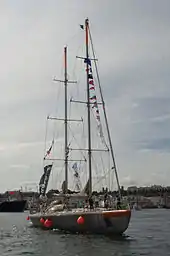Tara expedition
The Tara expedition is an oceanic research expedition.
.jpg.webp) Schooner Tara. | |
| History | |
|---|---|
| Name: |
|
| Builder: | SFCN Villeneuve-la-Garenne |
| In service: | 1989 |
| Homeport: | Lorient, France |
| General characteristics | |
| Type: | Schooner |
| Displacement: | 130 t (128 long tons) |
| Length: | 36 m (118 ft 1 in) |

The boat
Tara is a 36-metre aluminum-hulled schooner, formerly named "Antarctica" then "Seamaster".[2] Designed by the naval architecs Olivier Petit and Luc Bouvet, built in France on the initiative of Jean-Louis Étienne, medical explorer, in 1989 the schooner Antarctica was used from 1991 to 1996 by Jean-Louis Étienne for scientific expeditions in Antarctica, at the Erebus volcano and then wintering at Spitzberg. Under its former name, it was owned by Peter Blake, who was shot and killed in 2001 by pirates while sailing Seamaster on the Amazon River.[2] Following Blake's death, the yacht was bought by Etienne Bourgois, renamed Tara and dedicated to environmental expeditions.[3]
Expeditions
The polar schooner Tara set out to drift in the ice for approximately two years from its first departure, late in August 2006. The expedition met with interest in the oceanography community, especially in the context of the International Polar Year (2007–2008). Dubbed Tara Arctic, this voyage ended on February 23, 2008. It was part of the international DAMOCLES (Developing Arctic Modelling and Observing Capabilities for Long-term Environmental Studies) program.

In 2009, Tara started a new expedition, dubbed Tara Oceans.[4] It travelled around the world until 2013 to study CO2 capture by marine microorganisms such as plankton. The costs of the expedition were €3 million per year, all from private funds. The expedition was primarily funded by the French fashion designer agnès b.[5] It was able to collect more than 35,000 planktonic samples from 210 stations in every major oceanic region, which through analyses revealed more than 40 million genes, most of which were new to science.[4][6]
Tara Mediterranean was the next expedition, followed by Tara Pacific beginning in May 2016. During this latest voyage Tara is studying coral reefs and plastic pollution.
See also
References
- Pesant, S., Not, F., Picheral, M., Kandels-Lewis, S., Le Bescot, N., Gorsky, G., Iudicone, D., Karsenti, E., Speich, S., Troublé, R. and Dimier, C. (2015) "Open science resources for the discovery and analysis of Tara Oceans data". Scientific data, 2(1): 1–16. doi:10.1038/sdata.2015.23.
- "Sir Peter Blake's former yacht sails into Whangarei".
- Ainsworth, Claire (5 September 2013). "Systems ecology: Biology on the high seas". Nature. 501 (7465): 20–23. doi:10.1038/501020a. PMID 24005399.
- "Tara Oceans expedition yields treasure trove of plankton data". Science Daily. ScienceDaily. 21 May 2015. Retrieved 17 August 2015.
- Morelle, Rebecca (22 May 2015). "Ocean's hidden world of plankton revealed in 'enormous database'" – via www.bbc.com.
- "Tara Oceans expedition: researchers map the world of plankton". UNESCO. UNESCO. 26 May 2015. Retrieved 17 August 2015.
External links
- Official site
- "Life Aboard The Tara Oceans Expedition". YouTube. Voice of the Sea TV. February 1, 2014.
- "Tara Oceans: Cells, Embryos, and the Origins of Complexity in Life || Radcliffe Institute". YouTube. Harvard University. October 23, 2018. (A Lecture by Eric Karsenti)